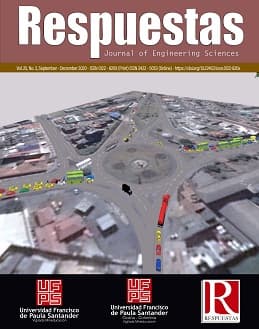Simulation of level and pressure control in the dome of a watertube boiler using the Control Station® (LOOP-PRO)
Simulación del control nivel y presión en el domo de una caldera acuotubular usando Control Station® (LOOP-PRO)
Main Article Content
The present work consisted of the simulation of the automatic control in the dome of a water tube boiler, to know in detail the behavior of the level and pressure and its influence on the operation of the boiler. To obtain the dynamics of each of the variables in the dome, the boiler software was used. Different disturbances were performed in manual mode to collect data and later fit them to a dynamic model. With the adjusted functions, a 2x2 MIMO multivariable control strategy was proposed, which was validated with the relative gain criterion proceeding to the decoupling methodology.
The parameters of each controller were tuned by the BLT method for multivariate systems and validated with the Nyquist stability criterion. The 2x2 system was simulated in the Control Station software with the controllers in automatic mode and step-type disturbances were performed to observe the influence that each parameter of the PID controller has on the response time, oscillation and offset of the controlled variables and their reflection on the other variables. With the criteria of overshoot and rise time, each parameter was retuned.
To ensure that the dynamics in the dome remains controlled, disturbances were made for servo control and regulator control, obtaining satisfactory results for each system. PID controllers were shown to respond quickly and efficiently
Downloads
Article Details
F. Bonilla Macuil, J. C., Zavala González, “Construcción de un generador de vapor con capacidad para 7.5 kg/hr de gasto a 10 Bar. de presión y 220oc y manual de uso, reglas de seguridad y mantenimiento del mismo; así como prácticas de laboratorio,” Universidad de las Américas Puebla, 2003.
I. M. Chew, F. Wong, A. Bono, J. Nandong, and K. I. Wong, “Performance Analysis of the Level Control with Inverse Response by using Particle Swarm Optimization,” in Lecture Notes in Electrical Engineering, 2020, vol. 603, pp. 55–64, doi: 10.1007/978-981-15-0058-9_6.
D. Cooper, J. Arbogast, and R. Jyringi, “Modeling, analysis and tuning tools for teaching process dynamics and control,” in AIChE Annual Meeting, Conference Proceedings, 2005, p. 3566.
C. D. Rocco and R. Morabito, “Um modelo de otimização para as operações de produção de vapor em caldeiras industrials,” Gestao e Producao, 2012, doi: 10.1590/S0104-530X2012000200004.
A. Serbezov and D. Cummings, “University-Industry Co-Operation to Promote Industrial Relevance in the Field Instrumentation Component of Control Education,” IFAC-PapersOnLine, vol. 49, no. 6, pp. 309–313, 2016, doi: 10.1016/j.ifacol.2016.07.195.
A. Serbezov and R. Rice, “Imparting Industrially Relevant Process Control Skills in Chemical Engineering Students with LOOP-PRO TRAINER,” in IFAC-PapersOnLine, 2019, vol. 52, no. 9, pp. 33–35, doi: 10.1016/j.ifacol.2019.08.118.
H. He and Y. Tan, “An optimizing parameter-tuning of multi-loop controllers for boiler combustion process,” in Proceedings of the 2nd IASTED Asian Conference on Modelling, Identification, and Control, AsiaMIC 2012, 2012, pp. 78–83, doi: 10.2316/P.2012.769-029.
J. Gaines and D. Nash, “Batch control gets easier,” Chemical Processing, vol. 72, no. 2, pp. 39–41, Feb. 2009.
H. Pan, W. Zhong, Z. Wang, and G. Wang, “Optimization of industrial boiler combustion control system based on genetic algorithm,” Computers and Electrical Engineering, vol. 70, pp. 987–997, Aug. 2018, doi: 10.1016/j.compeleceng.2018.03.003.
V. Köppel, M. Segal, and M. Remer, “Análisis de Estrategias de Desacoplamiento en Sistemas Interactuantes de Control de Procesos,” Informacion Tecnologica, 2004, doi: 10.4067/s0718-07642004000600013.
J. Moreno Lemos and R. A. Trujillo Perez, “Simulación dinámica y estrategias de control en el domo de una caldera acuatubular,” Universidad del Valle, 2006.
I. M. Chew, F. Wong, A. Bono, J. Nandong, and K. I. Wong, “Feedforward plus feedback control scheme and computational optimization analysis for integrating process,” in Lecture Notes in Electrical Engineering, 2019, vol. 481, pp. 359–368, doi: 10.1007/978-981-13-2622-6_35.
F. G. Shinskey, “Process Control: As Taught vs as Practiced,” Industrial & Engineering Chemistry Research, vol. 41, no. 16, pp. 3745–3750, Aug. 2002, doi: 10.1021/ie010645n.
S. C. A. & C. B.Armando, “Principles and practice of automatic process control,” Automatica, 1997.
T. E. Marlin, “The software laboratory for undergraduate process control education,” Computers & Chemical Engineering, vol. 20, no. SUPPL.2, pp. S1371–S1376, Jan. 1996, doi: 10.1016/0098-1354(96)00235-9.
D. J. Cooper, “Practical Process Control using Loop-Pro Software,” Control Station, Inc., 2005.
W. L. LUYBEN, Process modeling, simulation and control for chemical engineers, 2 ed. Mc Graw Hill, 1990.




 Perfil Google Scholar
Perfil Google Scholar



